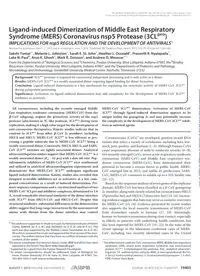
2015 Ligand-induced Dimerization of Middle East Respiratory Syndrome (MERS) Coronavirus nsp5 Protease (3CL_ PDF
Preview 2015 Ligand-induced Dimerization of Middle East Respiratory Syndrome (MERS) Coronavirus nsp5 Protease (3CL_
Ligand-induced Dimerization of Middle East Respiratory Syndrome (MERS) Coronavirus nsp5 Protease (3CLpro) IMPLICATIONS FOR nsp5 REGULATION AND THE DEVELOPMENT OF ANTIVIRALS* Received for publication,March 11, 2015, and in revised form, June 3, 2015 Published, JBC Papers in Press,June 8, 2015, DOI 10.1074/jbc.M115.651463 Sakshi Tomar‡1, Melanie L. Johnston§, Sarah E. St. John‡, Heather L. Osswald§, Prasanth R. Nyalapatla§, Lake N. Paul¶, Arun K. Ghosh§, Mark R. Denison�, and Andrew D. Mesecar‡§2 From the Departments of ‡Biological Sciences and §Chemistry, Purdue University, West Lafayette, Indiana 47907, the ¶Bindley Bioscience Center, Purdue University, West Lafayette, Indiana 47907, and the �Departments of Pediatrics and Pathology, Microbiology and Immunology, Vanderbilt University Medical Center, Nashville, Tennessee 37232 Background: 3CLpro protease is required for coronaviral polyprotein processing and is only active as a dimer. Results: MERS-CoV 3CLpro is a weakly associated dimer requiring ligand binding for dimer formation. Conclusion: Ligand-induced dimerization is a key mechanism for regulating the enzymatic activity of MERS-CoV 3CLpro during polyprotein processing. Significance: Activation via ligand-induced dimerization may add complexity for the development of MERS-CoV 3CLpro inhibitors as antivirals. All coronaviruses, including the recently emerged Middle East respiratory syndrome coronavirus (MERS-CoV) from the �-CoV subgroup, require the proteolytic activity of the nsp5 protease (also known as 3C-like protease, 3CLpro) during virus replication, making it a high value target for the development of anti-coronavirus therapeutics. Kinetic studies indicate that in contrast to 3CLpro from other �-CoV 2c members, including HKU4 and HKU5, MERS-CoV 3CLpro is less efficient at pro- cessing a peptide substrate due to MERS-CoV 3CLpro being a weakly associated dimer. Conversely, HKU4, HKU5, and SARS- CoV 3CLpro enzymes are tightly associated dimers. Analytical ultracentrifugation studies support that MERS-CoV 3CLpro is a weakly associated dimer (Kd �52 �M) with a slow off-rate. Pep- tidomimetic inhibitors of MERS-CoV 3CLpro were synthesized and utilized in analytical ultracentrifugation experiments and demonstrate that MERS-CoV 3CLpro undergoes significant ligand-induced dimerization. Kinetic studies also revealed that designed reversible inhibitors act as activators at a low com- pound concentration as a result of induced dimerization. Pri- mary sequence comparisons and x-ray structural analyses of two MERS-CoV 3CLpro and inhibitor complexes, determined to 1.6 A˚ , reveal remarkable structural similarity of the dimer interface with 3CLpro from HKU4-CoV and HKU5-CoV. Despite this structural similarity, substantial differences in the dimerization ability suggest that long range interactions by the nonconserved amino acids distant from the dimer interface may control MERS-CoV 3CLpro dimerization. Activation of MERS-CoV 3CLpro through ligand-induced dimerization appears to be unique within the genogroup 2c and may potentially increase the complexity in the development of MERS-CoV 3CLpro inhib- itors as antiviral agents. Coronaviruses (CoVs)3 are enveloped, positive-strand RNA viruses that infect a variety of vertebrates, including bats, live- stock, pets, poultry, and humans (1–3). Although human CoVs cause respiratory illnesses of mild to moderate severity (4–9), two recently emerged CoVs, severe acute respiratory syndrome coronavirus (SARS-CoV) and Middle East respiratory syn- drome coronavirus (MERS-CoV), have demonstrated their potential to become a serious threat to public health. MERS- CoV emerged late in 2012, and unlike its predecessor SARS- CoV, MERS-CoV continues to exhibit up to a 35% fatality rate (10–12). Based on the sequence analysis of seven genes of the replicase domain, MERS-CoV has been classified as a �-CoV genogroup 2c member, along with closely related bat coronaviruses HKU5 (Pipistrellus bat) and HKU4 (Tylonycteris bat) (13, 14). Increas- ing evidence suggests that bats may serve as zoonotic reservoirs for MERS-CoV (15, 16). Evidence presented by recent studies also supports the local zoonotic transmission of MERS-CoV from dromedary camels to humans (17, 18). Alarmingly, human-to-human transmission during close contact, especially in elderly or patients with underlying health conditions, has also been reported for MERS-CoV (19–22). In the wake of the recent upsurge in the laboratory-confirmed cases of MERS- CoV, including two recently identified cases in the United * Thisworkwassupported,inwholeorinpart,byNationalInstitutesofHealth Grants AI08508 (to A. D. M.) and AI026603 (to A. D. M. and M. R. D.). This work was also supported by the Walther Cancer Foundation (to A. D. M.). All authors reviewed the results and approved the final version of the man- uscript. The authors declare that they have no conflicts of interest with the contents of this article. The atomic coordinates and structure factors (codes 4RSP and 4YLU) have been deposited in the Protein Data Bank (http://wwpdb.org/). 1 Supported by a grant from the Purdue Research Foundation. 2 To whom correspondence should be addressed: Dept. of Biological Sci- ences, Purdue University, 915 W. State St., West Lafayette, IN 47907. Tel.: 765-494-1924; E-mail:
